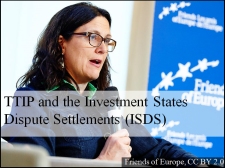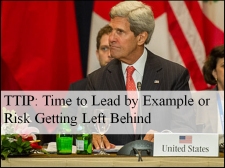Analysis by Gabriella ATKINS.
TTIP stands for the Transatlantic Trade and Investment Partnership, a deal currently being negotiated between the EU and the US which seeks to reduce or remove barriers to trade and foreign investment. It is unlikely that an agreement will be finalised before 2016, but it is likely that America’s recent Trans-Pacific Partnership (TPP) deal will influence proceedings.

On a basic level, TTIP would remove almost all tariffs on trade between the EU and the US. However tariffs (tax on imported goods) are currently low, due to both countries’ involvement in the World Trade Organisation (WTO), as well as agreements such as EU-US Open Skies Agreement and the Transatlantic European Council. Despite these measures, economic relations between the EU and the US remain tense. However, it must be realised that TTIP is not an innovative, isolated agreement. In 1990, following the end of the Cold War, the European Community and the US signed a Transatlantic Declaration which sought to facilitate economic relations. Since this date more agreements have been signed and TTIP is just another – albeit larger – step in the process.
Due to the secrecy of negotiations, it is difficult to predict exactly what will be contained in TTIP. However, the European Commission released documents in July 2014 (following a leak), dividing the topics into three areas: market access; specific regulation; and broader rules and principles and modes of co-operation.
With regards to regulation, a key argument of the European Commission is that EU and US rules concerning consumer safety and product quality often achieve the same results but require different methods. This inevitably increases costs to businesses. TTIP would seek to ‘harmonise’ this regulatory rules and therefore reducing export costs, encouraging more exportation. However, this is a key area of contention. Critics argue that such actions would remove an individual governments’ right to regulate for their public interest and harmonisation would only lead to a decrease in safety regulations and standards.
Regarding investment, TTIP would aim to increase transatlantic investment by creating a supra-national set of rules and regulations which would supersede individual national biases and prohibitive discrimination. If an investor felt these rules had been breached, they would be able to access a system known as investor state dispute settlement (ISDS), which would award compensation as it saw fit. ISDS facilities are a common feature of international trade agreements, again nothing new. But in light of TTIP, ISDS has prompted particularly heated dispute. Critics cite recent incomplete headline cases and argue governments would be discouraged from regulating in light of their public’s interest for fear of being brought to the ISDS by companies adversely affected by policy changes.
So, TTIP is a trade agreement between the EU and the US that would seek to reduce or remove tariffs. Given the secretive nature of discussions, that is all that can clearly be known. Most of the controversy over TTIP arises from the fact that individuals do not know specifically what the agreement contains. However, if an agreement is reached, it would still have a long road to travel. In the EU, each of the 28 Member States would have to approve or reject the agreement in the EU Council of Ministers. Endorsement from the European Parliament will also be required. Individual Member States would also have individual processes for ratifying the agreement. In the US, both houses of Congress would have to pass the agreement, currently President Obama struggled to convince Congress to allow him a Trade Promotion Authority which would ease US ratification.
RELATED ARTICLES:





